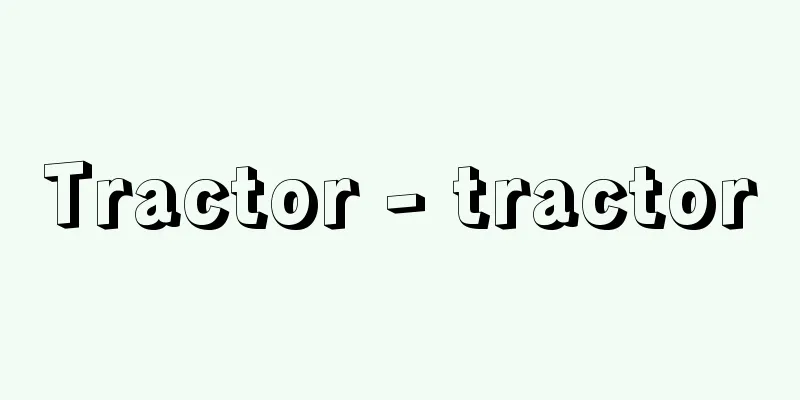Tractor - tractor

|
This refers to a towing vehicle. There are agricultural and construction tractors, but this article will mainly discuss agricultural tractors. Agricultural tractors are used to pull or drive implements attached to them for work. Today's four-wheel tractors were manufactured by Henry Ford in 1917, and later became fully-fledged tractors in terms of mechanics and structure, with the addition of power take-off shafts (PTO shafts) for driving implements, diesel engines, pneumatic tires, and three-point linkages for attaching implements. Their performance and functionality have improved over time with the adoption of anti-vibration measures for the engine, improved forward visibility, multi-speed and automatic transmissions to accommodate various types of work, and shuttle transmissions that can switch between forward and reverse. Foreign-made tractors were introduced to Japan at the end of the Taisho era, but they were only used for land reclamation in Hokkaido. After World War II, around 1950, walk-behind tractors were domestically produced and quickly became popular. Around 1960, as agricultural workers moved to other industries, efficient four-wheeled riding tractors became more popular. Agricultural tractors are divided into three types according to the running gear: wheeled tractors, tracked tractors (also called caterpillar tractors), and semi-crawler tractors. Wheeled tractors are highly maneuverable and are the most common type. Walking tractors are generally called tillers, and riding tractors are called tractors. There are two-wheel drive tractors, where only the rear wheels are driven, and four-wheel drive tractors, where both the front and rear wheels are driven, with four-wheel drive being the most widely used. Tracked tractors have high traction power and low ground pressure, and are used for deep plowing and working on soft soil. Half-track tractors have the rear wheels of a four-wheel drive tractor replaced with crawlers, and are used to improve driving performance in wet fields, etc. Special tractors include slope tractors, which have a low center of gravity and are less likely to tip over, and tool carriers, which have a structure somewhere between a tractor and a truck. In terms of work safety, the installation of a safety cab (driver's compartment) and safety frame are important measures to prevent injury or death to the operator in the event of a tractor tipping over. It is important to select and install products that are compatible with the tractor. In addition to preventing injury or death in tipping over accidents, safety cabs also have the effect of enabling the operator to work comfortably by providing sound insulation, vibration protection, protection from rain, cold, heat, and dust, etc. In addition, tractors for non-agricultural purposes include construction bulldozers and wheel loaders, and more specialized ones such as towing tractors used to tow aircraft at airports. [Shigeru Yagi] [Reference] | | |Source: Shogakukan Encyclopedia Nipponica About Encyclopedia Nipponica Information | Legend |
|
牽引(けんいん)車両のことをいう。農業用、建設用などがあるが、本項では、おもに農業用トラクターについて述べる。 農業用トラクターは、作業機を装着して牽引したり、駆動しながら作業を行う。現在のような4輪トラクターは1917年にヘンリー・フォードによって製造され、その後、作業機を駆動するための動力取出し軸(PTO軸)、ディーゼル機関の搭載、空気タイヤの装着、作業機を取り付ける3点リンク機構が装備され、機構的、構造的に本格的なトラクターとなった。その性能・機能は、エンジンの防振対策、前方視野の改善、各種作業に適応するための多段変速化や自動変速機構、前後進の切替えのできるシャトル変速機構等の採用と、時代とともに向上している。 日本では大正末期ごろに外国製のトラクターが導入されたが、北海道での開墾などに利用されただけであった。第二次世界大戦後、1950年(昭和25)ごろから歩行型トラクターが国産化され、急速に普及した。1960年ごろから、農業従事者の他産業への流出により、能率の高い乗用型の4輪トラクターの普及をみた。 農業用トラクターの種類は、走行装置によって、車輪式(ホイール式トラクター)、装軌式(クローラー式トラクター。キャタピラー式ともいう)、半装軌式(セミクローラー式トラクター)に分けられる。車輪式は機動性に富み、もっとも普及している方式である。一般に歩行型トラクターは耕うん機とよばれ、乗用型トラクターがトラクターとよばれている。 トラクターには後輪だけを駆動する2輪駆動トラクターと、前後輪とも駆動する4輪駆動トラクターとがあり、4輪駆動がもっとも多く使用されている。装軌式トラクターは、牽引出力が大きいこと、接地圧が低いことにより、深耕用プラウの作業や柔軟地での作業に利用されている。半装軌式トラクターは4輪駆動式トラクターの後輪部分をクローラーにしたもので、湿田等での走行性改善のために使用されている。 特殊なトラクターには、重心位置が低く転倒しにくい傾斜用トラクター、トラクターとトラックの中間的構造をしたツールキャリアーなどがある。 作業安全の面では、トラクターの転倒事故に際しオペレーターの死傷を防ぐ重要な手段として、安全キャブ(運転室)や安全フレームの装着がある。いずれもトラクターに適合した製品を選択し、装着することが重要である。安全キャブには転倒事故による死傷防止に加え、防音、防振、雨よけ、防寒、防暑、防塵等により、オペレーターの快適作業を可能にする効果もある。 なお、農業用以外のトラクターには、建設用のブルドーザー、ホイールローダー等があり、特殊なものでは空港で航空機を牽引するトーイングトラクターなどもある。 [八木 茂] [参照項目] | | |出典 小学館 日本大百科全書(ニッポニカ)日本大百科全書(ニッポニカ)について 情報 | 凡例 |
Recommend
Uenohara
The former name of a town (Uenohara-machi) was in...
Hay, J.
…One of his early works is Cardinal Rolin's N...
Ariyama Tomb - Ariyama Tomb
This square tomb, 45m on each side, is located in ...
Property rights - property
In private law, it refers to the right to directl...
map interpretation
...The boundary lines of a 1:10,000 topographical...
University of Vienna
Vienna is a comprehensive university located in t...
Bukeho (Samurai Law)
The legal system during the period when samurai w...
Cytostome
… [Invertebrate Mouth] Animals that do not have a...
Contract - Contract
A document made to promise a future action. It is...
Cloud-like Ueno Hatsuhana - Cloud-like Ueno Hatsuhana
A Kabuki play. A domestic drama in seven acts. Wr...
Ecran Mountain Wall - Ecran Sanpeki
The eastern part of the region is made up of the ...
Museum - Hakubutsukan (English spelling) museum
In Japan, the Museum Law was enacted in the spiri...
Forgiveness - forgiveness
This refers to the arts and martial arts that are ...
Eastern colonization (English spelling) Ostkolonisation German
The colonization of the Slavic regions of the Eas...
Hepatomegaly
Concept Hepatomegaly is a condition in which the l...









